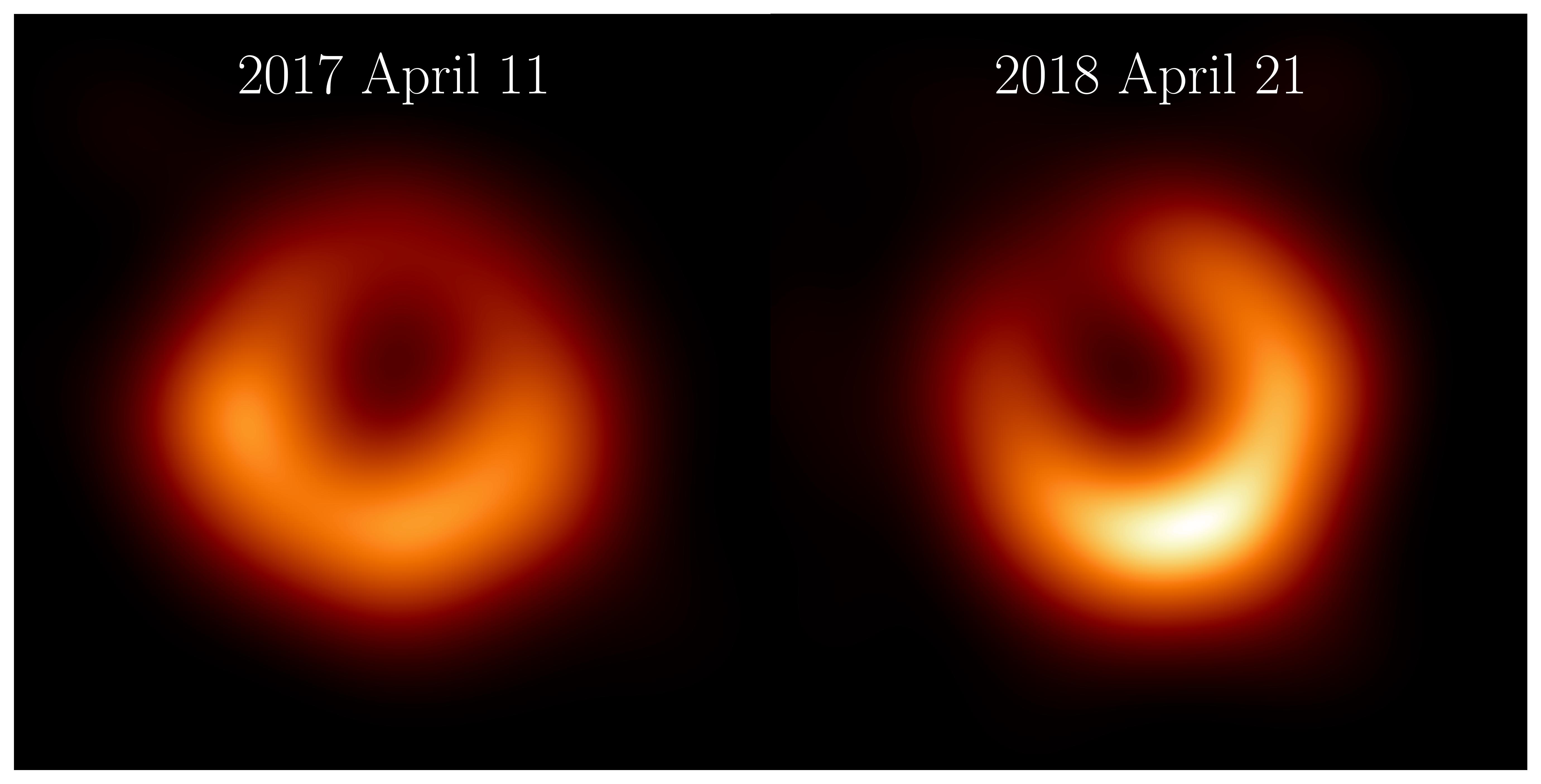The Event Horizon Telescope (EHT) Collaboration has released new images of M87*, the supermassive black hole at the center of the galaxy Messier 87, using data from observations taken in April 2018. With the participation of the newly commissioned Greenland Telescope and a dramatically improved recording rate across the array, the 2018 observations give us a view of the source independent from the first observations in 2017.
A recent paper published in the journal Astronomy & Astrophysics presents new images from the 2018 data that reveal a familiar ring the same size as the one observed in 2017. This bright ring surrounds a deep central depression, “the shadow of the black hole,” as predicted by general relativity. Excitingly, the brightness peak of the ring has shifted by about 30º compared to the images from 2017, which is consistent with our theoretical understanding of variability from turbulent material around black holes.
“Confirming the existence of the bright ring and the size of the shadow of the supermassive black hole at the center of the galaxy M87 is important because it tells us that the results of the 2017 observations are robust,” says Laurent Loinard, researcher at the Institute of Radio Astronomy and Astrophysics (IRyA) at UNAM, Campus Morelia, and part of the EHT collaboration. “The changes in the position of the brightest part of the ring, which occur over a few months or a year, were expected due to theoretical predictions”, which can be made “once the main characteristics of the black hole are known, such as its mass, its rotation speed, the orbital period of the gas disk around it, and the properties of that gas”, mentions Alejandro Cruz Osorio, from the Institute of Astronomy (IA) at UNAM in Mexico City, also part of the EHT collaboration.
The analysis of the data obtained in 2018 took a long time because these data “are difficult to calibrate and analyze,” comments Laurent Loinard, adding that “the collaboration was very busy analyzing the Sgr A* results from the 2017 observing campaign, which were published in 2022, and this delayed the analysis of the 2018 data.” Sgr A* is the supermassive black hole at the center of our galaxy, the Milky Way.
While the new image of M87* confirms previously published results, it also has some significant differences. “On the operational side, this image incorporates new telescopes that did not participate in 2017,” in particular the Greenland Telescope, “so it has better fidelity and slightly better resolution,” Laurent Loinard highlights. “On the scientific side, the main difference is that the most intense (bright) part of the ring is not exactly in the same position, and this change was expected,” to which Alejandro Cruz Osorio adds that “it was measured that the bright zone was shifted by 30 degrees compared to its position in the 2017 image.”
 The Event Horizon Telescope Collaboration has released new images of M87* from observations taken in April 2018, one year after the first observations in April 2017. The new observations in 2018, which feature the first participation of the Greenland Telescope, reveal a familiar, bright ring of emission of the same size as we found in 2017. This bright ring surrounds a dark central shadow, and the brightest part of the ring in 2018 has shifted by about 30º relative from 2017 to now lie in the 5 o’clock position. Credit: EHT Collaboration
The Event Horizon Telescope Collaboration has released new images of M87* from observations taken in April 2018, one year after the first observations in April 2017. The new observations in 2018, which feature the first participation of the Greenland Telescope, reveal a familiar, bright ring of emission of the same size as we found in 2017. This bright ring surrounds a dark central shadow, and the brightest part of the ring in 2018 has shifted by about 30º relative from 2017 to now lie in the 5 o’clock position. Credit: EHT Collaboration
Science needs to be reproducible, replicable and improvable
“A fundamental requirement of science is to be able to reproduce results,” says Dr. Keiichi Asada, an associate research fellow at Academia Sinica Institute for Astronomy and Astrophysics in Taiwan. “Confirmation of the ring in a completely new data set is a huge milestone for our collaboration and a strong indication that we are looking at a black hole shadow and the material orbiting around it.”
In 2017, the EHT took the first image of a black hole. This object, M87*, is the beating heart of the giant elliptical galaxy Messier 87 and lives 55 million light years away from Earth. The image of the black hole revealed a bright circular ring, brighter in the southern part of the ring. Further analysis of the data also revealed the structure of M87* in polarized light, giving us greater insight into the geometry of the magnetic field and the nature of the plasma around the black hole.
The new era of black hole direct imaging, spearheaded by the extensive analysis of the 2017 observations of M87* opened a new window that let us investigate black hole astrophysics and allow us to test the theory of general relativity at a fundamental level. Our theoretical models tell us that the state of the material around M87* should be uncorrelated between 2017 and 2018. Thus, multiple observations of M87* will help us place independent constraints on the plasma and magnetic field structure around the black hole and help us disentangle the complicated astrophysics from the effects of general relativity.
To help accomplish new and exciting science, the EHT is under continuous development. The Greenland Telescope joined the EHT for the first time in 2018, just five months after its construction was completed far above the Arctic Circle. This new telescope significantly improved the image fidelity of the EHT array, improving the coverage, particularly in the North-South direction. The Large Millimeter Telescope also participated for the first time with its full 50 m surface, greatly improving its sensitivity. The EHT array was also upgraded to observe in four frequency bands around 230 GHz, compared to only two bands in 2017.
Repeated observations with an improved array are essential to demonstrate the robustness of our findings and strengthen our confidence in our results. In addition to the groundbreaking science, the EHT also serves as a technology testbed for cutting-edge developments in high-frequency radio interferometry.
“Advancing scientific endeavors requires continuous enhancement in data quality and analysis techniques,” said Rohan Dahale, a PhD candidate at the Instituto de Astrofísica de Andalucía (IAA-CSIC) in Spain. “The inclusion of the Greenland Telescope in our array filled critical gaps in our earth-sized telescope. The 2021, 2022, and the forthcoming 2024 observations witness improvements to the array, fueling our enthusiasm to push the frontiers of black hole astrophysics.”
The analysis of the 2018 data features eight independent imaging and modeling techniques, including methods used in the previous 2017 analysis of M87* and new ones developed from the collaboration’s experience analyzing Sgr A*.
The image of M87* taken in 2018 is remarkably similar to what we saw in 2017. We see a bright ring of the same size, with a dark central region and one side of the ring brighter than the other. The mass and distance of M87* will not appreciably increase throughout a human lifetime, so general relativity predicts that the ring diameter should stay the same from year to year. The stability of the measured diameter in the images from 2017 to 2018 robustly supports the conclusion that M87* is well described by general relativity.
“One of the remarkable properties of a black hole is that its radius is strongly dependent on only one quantity: its mass,” said Dr. Nitika Yadlapalli Yurk, a former graduate student at the California Institute of Technology (Caltech), now a postdoctoral fellow at the Jet Propulsion Laboratory in California. “Since M87* is not accreting material (which would increase its mass) at a rapid rate, general relativity tells us that its radius will remain fairly unchanged over human history. It’s pretty exciting to see that our data confirm this prediction.”
While the size of the black hole shadow did not change between 2017 and 2018, the location of the brightest region around the ring did change significantly. The bright region rotated about 30º counterclockwise to settle in the bottom right part of the ring at about the 5 o’clock position. Historical observations of M87* with a less sensitive array and fewer telescopes also indicated that the shadow structure changes yearly but with less precision. While the 2018 EHT array still cannot observe the jet emerging from M87*, the black hole spin axis predicted from the location of the brightest region around the ring is more consistent with the jet axis seen at other wavelengths.
“The biggest change, that the brightness peak shifted around the ring, is actually something we predicted when we published the first results in 2019,” said Dr. Britt Jeter, a postdoctoral fellow at Academia Sinica Institute for Astronomy and Astrophysics in Taiwan. “While general relativity says the ring size should stay pretty fixed, the emission from the turbulent, messy accretion disk around the black hole will cause the brightest part of the ring to wobble around a common center. The amount of wobble we see over time is something we can use to test our theories for the magnetic field and plasma environment around the black hole.”
While all the EHT papers published so far have featured an analysis of our first observations in 2017, this result represents the first efforts to explore the many additional years of data we’ve collected. In addition to 2017 and 2018, the EHT conducted successful observations in 2021 and 2022 and is scheduled to observe in the first half of 2024. Each year, the EHT array has improved in some way, either through the addition of new telescopes, better hardware, or additional observing frequencies. Within the collaboration, we are working very hard to analyze all this data and are excited to show you more results in the future.
More Information about the Event Horizon Telescope
The EHT collaboration involves more than 300 researchers from Africa, Asia, Europe, and North and South America. The international collaboration is working to capture the most detailed black hole images ever obtained by creating a virtual Earth-sized telescope. Supported by considerable international investment, the EHT links existing telescopes using novel systems, creating a fundamentally new instrument with the highest angular resolving power that has yet been achieved.
The individual telescopes involved are ALMA, APEX, the IRAM 30-meter Telescope, the IRAM NOEMA Observatory, the James Clerk Maxwell Telescope (JCMT), the Large Millimeter Telescope (LMT), the Submillimeter Array (SMA), the Submillimeter Telescope (SMT), the South Pole Telescope (SPT), the Kitt Peak Telescope, and the Greenland Telescope (GLT). Data were correlated at the Max-Planck-Institut für Radioastronomie (MPIfR) and MIT Haystack Observatory. The postprocessing was done within the collaboration by an international team at different institutions.
The EHT consortium consists of 13 stakeholder institutes: the Academia Sinica Institute of Astronomy and Astrophysics, the University of Arizona, the University of Chicago, the East Asian Observatory, Goethe-Universitaet Frankfurt, Institut de Radioastronomie Millimétrique, Large Millimeter Telescope, Max Planck Institute for Radio Astronomy, MIT Haystack Observatory, National Astronomical Observatory of Japan, Perimeter Institute for Theoretical Physics, Radboud University, and the Smithsonian Astrophysical Observatory.
Mexico in the Event Horizon Telescope
The Alfonso Serrano Large Millimeter Telescope, located on the Sierra Negra volcano in the state of Puebla, is one of the radio wave observatories that participates in the Event Horizon Telescope. It is maintained by the National Institute of Astrophysics, Optics and Electronics (INAOE) and the University of Massachusetts. The Mexican community that participates in the EHT collaboration includes at least 10 people in foreign or national institutions, such as the IRyA and IA, both at UNAM, and the INAOE.
EHT Collaboration contact in Mexico
Alejandro Cruz Osorio
Instituto de Astronomía, UNAM
Ciudad de México, México
Laurent Loinard
Instituto de Radioastronomía y Astrofísica, UNAM
Morelia, México
Media contact in Mexico
René A. Ortega Minakata
Instituto de Radioastronomía y Astrofísica, UNAM
Morelia, México
Text: IRyA UNAM based on the Event Horizon Telescope press release:
https://eventhorizontelescope.org/M87-one-year-later-proof-of-a-persistent-black-hole-shadow
International EHT Collaboration contact
Keiichi Asada
Academia Sinica Institute of Astronomy and Astrophysics
Taipei, Taiwan
Email:
Rohan Dahale
Instituto de Astrofísica de Andalucía (IAA-CSIC)
Granada, Spain
Email:
Nitika Yadlapalli Yurk
Jet Propulsion Laboratory
Pasadena, CA, USA
Email:
Britt Jeter
Academia Sinica Institute of Astronomy and Astrophysics
Taipei, Taiwan
Email:
Huib Jan van Langevelde
EHT Project Director
Joint Institute for VLBI ERIC
Dwingeloo, The Netherlands
Email:
Geoffrey C. Bower
EHT Project Scientist
Academia Sinica Institute of Astronomy and Astrophysics
Hilo, HI, USA
Email:
Mariafelicia de Laurentis]
EHT Deputy Project Scientist
University of Naples Federico II
Naples, Italy
Email:




